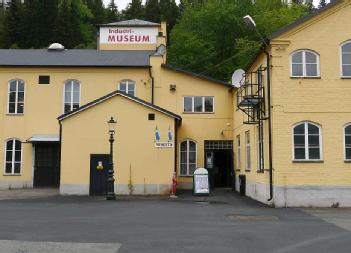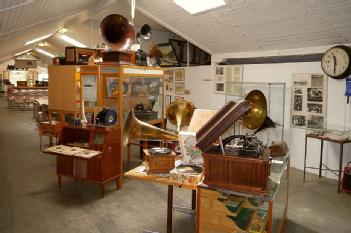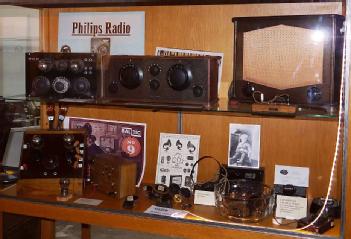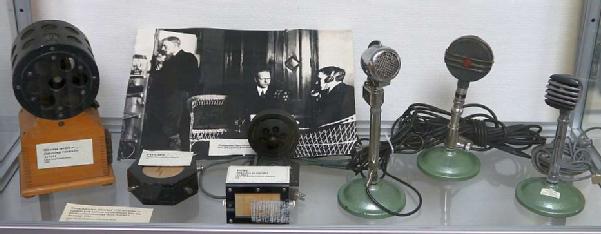Antique radios, Old Time Radios

| |
Norrahammars Industri- & Bygdemuseum
|
|
|
56232 Norrahammar, Sweden |
| Address |
Hammarvägen 39
|
| Floor area |
unfortunately not known yet
|
| |
- Wire- & tape recording
- Record players with pick up
- Radios (Broadcast receivers)
- Gramophone (no electrical sound transmission)
|
|
Opening times
|
23 April - 18 September, Saturdays and Sundays, 1pm - 5pm.
21 June - 21 August is the museum open daily, Mondays closed.
closed on Midsummer's Eve and Midsummer's Day, 24 and 25 June 2016.
lördagar och söndagar från lördagen den 23 april till söndagen den 18 september.
21 juni till 21 augusti är museet öppet tisdag till söndag.
Öppettider kl 13 - 17.
Midsommarafton och midsom-mardagen stängt. Gruppbesök mottages hela året!
|
|
Admission
Status from 10/2016
|
50 kr per person; Ungdom under 15 år gratis. Adults 50 SEK. Free for children under 15. |
|
| Contact |
| Tel.: | +46-36-31 66 21 | eMail: | info  industrimuseet.se industrimuseet.se |
|
|
| Homepage |
www.industrimuseet.se
|
Our page for Norrahammars Industri- & Bygdemuseum in Norrahammar, Sweden, is not yet administrated by a Radiomuseum.org member. Please write to us about your experience with this museum, for corrections of our data or sending photos by using the Contact Form to the Museum Finder.
| Location / Directions |
| N57.700133° E14.111729° | N57°42.00798' E14°6.70374' | N57°42'0.4788" E14°6'42.2244" |
Norrahammar is a part of the Jönköping locality in Sweden. It has been part of the town since the 1970s. It is located within the Jönköping Municipality in the county of Jönköping in Sweden.
|
|
Location / Directions
(other) |
Norrahammar är en kommundel i Jönköpings kommun vars bebyggelse ingår i tätorten Jönköping, belägen cirka 9 km sydväst om Jönköpings centrum. Ursprungligen ett brukssamhälle, uppväxt kring Norrahammars bruk, är Norrahammar sedan 1970-talet sammanvuxet med Jönköping och utgör den sydvästra delen av tätorten. Norrahammar ligger i Tabergsåns dalgång. Norrahammar ingår, tillsammans med Hovslätt, Månsarp och Taberg, i kommundelen Tabergsådalen. |
| Description
|
Text fom Museum:
From primitive iron handling to modern industry.
In the middle of Taberg creek valley, almost in the shadow of the hill that gave forge iron to the many hammermills, you can today find an industrial museum that illustrates this interesting history.
The museum is accessible at floor one and two. Elevator available.
On the first floor you will find the reception and the exhibition that illustrates the industrial epoch and on floor two the exhibition that shows the primitive iron handling.
The industrial epoch is illustrated by a number of objects and equipments from various earlier industrial activities in the Taberg valley and around Barnarp.
A large part of the exhibition also shows the social life during the building of society, with housing, trade etc.
An extensive amount material, such as texts and photos, supplement the exhibition and visitors can take part in the history of the Taberg valley by themselves.
The production of iron has a long history in the Taberg valley. Finds of small blast furnaces shows that iron was produced from red earth and marsch ore as early as in the Viking age.
Ore mining in Taberg dates back to the end of the 1400's and in 1618 the Swedish King Gustav II Adolf issued privileges for Tabergs Bergslag.
Ore from Taberg was used at some 20 blast furnaces around the area and played an importent part in the economical development in the hole province.
With our exhibition Primitive Ironhandling we want to show production from red earth to iron and rockore to pig-iron. |
|
Description
(other) |
Text från Museum:
Från primitiva järn hantering för modern industri
Framställning av järn har gamla anor i Tabergsådalen. Den äldsta ugnen i trakten, där järn framställts av rödjord, har daterats till 100 år e.Kr.
Malmen från Taberg användes sporadiskt redan under medeltiden. Brytningen påbörjades redan under slutet av 1400-talet. Den fick ordentlig fart när Gustav II Adolf 1618 utfärdade privilegier för Tabergs bergslag. Den ökade malmtillgången medförde att fler hytter och smidesverkstäder tillkom.
Från 1700-talet och framåt har röken från masugnarna varit en ständig påminnelse för traktens bönder om industrins utveckling. Stora skogsområden runt masugnarna blev kalhuggna för att ge bränsle till järnframställningen.
Det fanns 12 masugnar som kontinuerligt fylldes med järnmalm och dessa skulle hela tiden hålla en jämn temperatur och matades kontinerligt med kol. Masugnarna var i drift så länge kolet räckte och när den tog slut blev det några månaders uppehåll innan de kunde tändas upp igen.
Med vår utställning "Primitiv järnhantering" vill vi visa framställningen från rödjord till järn respektive från bergmalm till tackjärn. I en pedagogisk utställning på museets översta plan får du en bra överblick på hur processen gick till. Det finns flera modeller som förklarar funktionen hos masugnar, stångjärnshammare, kolmilor och annat som hör till järnutvinningen.
Vi vill ge museibesökaren en uppfattning om hur våra förfäder producerade järnet för redskaps- och vapentillverkning - och hur vår bygd förvandlades från ett bondesamhälle till en modern industriregion. |
Radiomuseum.org presents here one of the many museum pages. We try to bring data for your direct information about all that is relevant. In the list (link above right) you find the complete listing of museums related to "Radio & Co." we have information of. Please help us to be complete and up to date by using the
contact form above.
[dsp_museum_detail.cfm]
| Data Compliance |
More Information |
|
|
|

 industrimuseet.se
industrimuseet.se 







